I am using scipy optimize to get the minimum value on the following function:
def randomForest_b(a,b,c,d,e):
return abs(rf_diff.predict([[a,b,c,d,e]]))
I eventually want to be able to get the optimal values of (a) and (b) given the arguments (c,d,e). However, just to learn how to work the optimize function, I am trying to get the optimal value of (a) given the other arguments. I have the following code:
res=optimize.minimize(randomForest_b, x0=45,args=(119.908500,65.517527,2.766103,29.509200), bounds=((45,65),))
print(res)
And I have even tried:
optimize.fmin_slsqp(randomForest_b, x0=45,args=(119.908500,65.517527,2.766103,29.509200), bounds=((45,65),))
However, both of these just return the x0 value.
Optimization terminated successfully. (Exit mode 0)
Current function value: 1.5458542752157667
Iterations: 1
Function evaluations: 3
Gradient evaluations: 1
array([ 45.])
The current function value is correct, however between all numbers within the bounds, the x0 does not return the minimum function value. I have the bounds set because the variable a can only be a number between 45 and 65. Am I missing something or doing something wrong? And if possible, how can I get optimal values of a and b?
Here is an example of the complete code I am using:
from numpy import array
import scipy.optimize as optimize
from scipy.optimize import minimize
a=np.random.uniform(low=4.11, high=6.00, size=(50,))
b=np.random.uniform(low=50.11, high=55.99, size=(50,))
c=np.random.uniform(low=110.11, high=120.99, size=(50,))
d=np.random.uniform(low=50.11, high=60.00, size=(50,))
pv=np.random.uniform(low=50.11, high=60.00, size=(50,))
df=pd.DataFrame(a, columns=['a'])
df['b']=b
df['c']=c
df['d']=d
df['pv']=pv
df['difference']=df['pv']-df['d']
from sklearn.model_selection import train_test_split
y=df.loc[:, 'difference']
x=df.iloc[:, [0,1,2,3]]
x_train, x_test, y_train, y_test = train_test_split(x, y, test_size=0.25)
from sklearn.ensemble import RandomForestRegressor
rf_difference = RandomForestRegressor(n_estimators = 1000, oob_score=True,
random_state = 0)
rf_difference.fit(x_train, y_train)
def randomForest_b(a,b,c,d):
return abs(rf_difference.predict([[a,b,c,d]]))
res=optimize.minimize(randomForest_b,
x0=0,args=(51.714088,110.253656,54.582179), bounds=((0,6),))
print(res)
optimize.fmin_slsqp(randomForest_b, x0=0,args=
(51.714088,110.253656,54.582179),
bounds=((0,6),))

